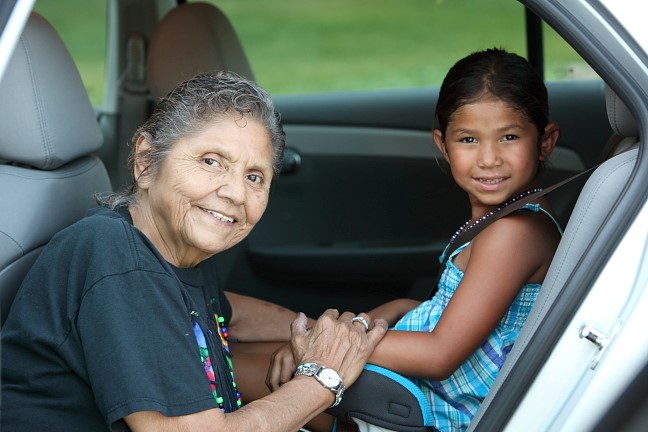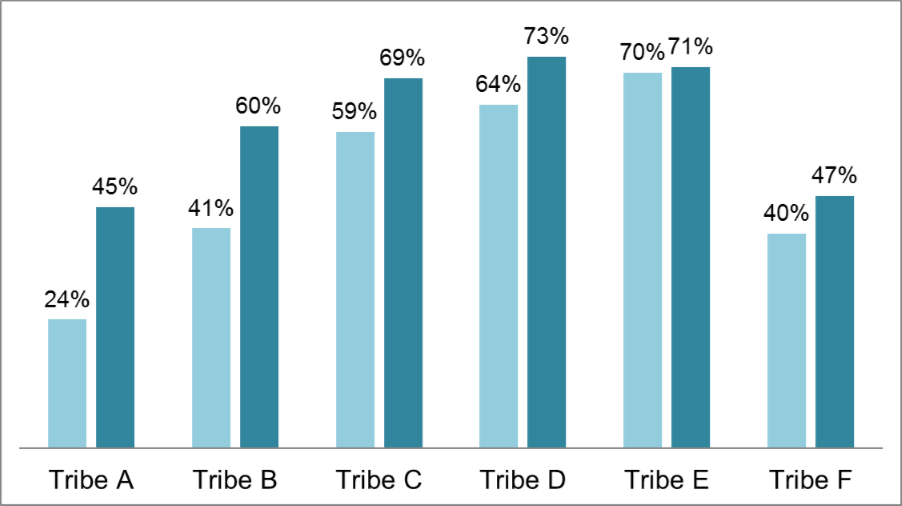The Native CARS (Native Children Always Ride Safe) Partnership: A Journey towards Improving Child Passenger Safety
 In the early 2000s, Northwest Tribes were concerned about the impact of motor vehicle–related injuries and deaths on their communities. The Northwest Tribal EpiCenter (NWTEC) confirmed a growing disparity in motor vehicle fatalities for American Indian children, with American Indians and Alaska Natives having the highest vehicle–related death rate of any group.1
In 2003, on behalf of the tribes, the NWTEC reached out to experts at Oregon Health & Science University (OHSU) in Portland and Harborview Injury Prevention and Research Center (HIPRC) in Seattle to form a partnership to investigate whether low rates of child safety seat use could be contributing to the motor vehicle fatality disparity. Together, the group assessed child safety seat use in six tribes and found that use of age- and size-appropriate child safety seats ranged from 25 percent to 55 percent.2
In the early 2000s, Northwest Tribes were concerned about the impact of motor vehicle–related injuries and deaths on their communities. The Northwest Tribal EpiCenter (NWTEC) confirmed a growing disparity in motor vehicle fatalities for American Indian children, with American Indians and Alaska Natives having the highest vehicle–related death rate of any group.1
In 2003, on behalf of the tribes, the NWTEC reached out to experts at Oregon Health & Science University (OHSU) in Portland and Harborview Injury Prevention and Research Center (HIPRC) in Seattle to form a partnership to investigate whether low rates of child safety seat use could be contributing to the motor vehicle fatality disparity. Together, the group assessed child safety seat use in six tribes and found that use of age- and size-appropriate child safety seats ranged from 25 percent to 55 percent.2
This assessment was the impetus for a proposal to the National Institute on Minority Health and Health Disparities (NIMHD) to fund a community-based participatory research (CBPR) collaboration between the NWTEC, HIPRC, and six Northwest Tribes to develop and test community-specific interventions aimed at increasing child safety seat use. The tribes named this study Native Children Always Ride Safe (Native CARS).

Tribes created multifaceted interventions with activities aimed at multiple sectors within communities, including parents, caregivers, healthcare providers, public health programs, and legal and law enforcement departments. Each set of activities was unique to the tribe’s readiness level, at-risk groups, and tribal culture. These interventions measurably increased rates of proper use of child passenger restraints and reduced rates of unrestraint, providing evidence that strategies developed for tribes by tribes work. Each tribe was successful at increasing the percentage of children riding in an age- and size-appropriate restraint (see Figure 1).

After seeing success in their own communities, the six tribes wanted to go beyond their own tribal boundaries and be responsive to the needs of American Indian and Alaska Native communities nationwide. Consequently, the Native CARS tribes disseminated their efforts, protocols, and products via the Native CARS Atlas, a web-based blueprint to address child passenger safety concerns, with the ultimate goal of reducing the number of fatalities and injuries from motor vehicle crashes among tribal children everywhere.
Through the Native CARS Atlas, tribes share a variety of approaches that increased child passenger restraint use and saved children’s lives. The atlas was designed to be used by diverse groups, including schools, parent groups, caregivers, parents, healthcare providers, public health programs, legal and law enforcement programs, emergency medical services, or traffic safety programs.
Tribes contributed authorship, oversight, and expertise in constructing 13 modules that share their knowledge, process, products, and stories, along with interactive tools for other tribes to use to create change within their own communities. These modules are displayed chronologically, from building a coalition to collecting data, using the data to develop various intervention activities, and disseminating results. In addition, vignettes share tribes’ experiences and successes, with quick links to resources to make navigation easy and relevant.
We invite you to visit Native CARS Atlas website. Before you get started, you’ll want to register by hovering over the “Log In” menu option and then clicking on the “register” button that appears.
The following resources are included in the Native CARS Atlas:
- A community readiness assessment with level-specific recommended activities
- A guide for building a coalition, along with a sample meeting agenda
- A tutorial for using the Fatality Analysis Reporting System (FARS) to map fatal crashes on reservations
- A survey instrument and protocol to determine the percentage of properly restrained children in a community, along with an Excel spreadsheet for entering data (tables and charts will auto-populate)
- Media templates for posters, billboards, radio and television PSAs
- Links to other sites for media created by other tribal communities
- Everything needed to start a child safety seat distribution program
- Individual success stories related to policy and law changes, along with a step-by-step guide for changing a tribal child passenger safety code
The Native CARS Atlas aims to capture the inherent strength of tribal communities in protecting the future generations through child passenger safety. All it takes is one person to make a difference. The Atlas aims to equip tribes with everything they need to increase child passenger restraint use in their own communities.
References
- Centers for Disease Control and Prevention, National Center for Injury Prevention and Control. (2017). Welcome to WISQARS (Web-based Injury Statistics Query and Reporting System).
- Lapidus, J. A., Smith, N. H., Ebel, B. E., & Romero, F. C. (2005). Restraint Use Among Northwest American Indian Children Traveling in Motor Vehicles. American Journal of Public Health, 95(11), 1982–1988. doi: 10.2105/AJPH.2004.052514. PMCID: PMC1449472
- Lapidus, J. A., Smith, N. H., Lutz, T., & Ebel, B. E. (2013). Trends and Correlates of Child Passenger Restraint Use in 6 Northwest Tribes: The Native Children Always Ride Safe (Native CARS) Project. American Journal of Public Health, 103(2), 355–361. doi: 10.2105/AJPH.2012.300834
- Smith, N. H, Lutz, T., & Lapidus, J. A. (2014). Improving Data on Child Passenger Safety: Survey Methods from the “Native Children Always Ride Safe” (Native CARS) Study. The IHS Primary Care Provider, 39(7), 120–124.
The mission of the Northwest Portland Area Indian Health Board (NPAIHB) is to eliminate health disparities and improve the quality of life for American Indians and Alaska Natives by supporting Northwest Tribes in their delivery of culturally appropriate, high-quality healthcare. Through its Northwest Tribal EpiCenter (NWTEC), NPAIHB aims to support and conduct culturally appropriate health research and surveillance among the Northwest Tribes.
Posted December 5, 2017

















